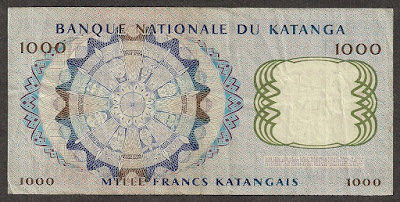 |
| Banknotes of Katanga - 1000 francs Katangais |
 |
| 1000 francs Katangais |
Katangan money currency, Katanga banknotes, Katanga paper money , Katanga bank notes.
Predominantly blue, the illustration on the front of the note is of a woman, with a baby on her back, harvesting cotton, while in the distance is another woman carrying a calabash of water on her head.
On the back of the note is a rosette, or wheel, of African masks and spears which is reminiscent of a globe of the world.
On both the front and back of the note is a white area which is left clear to allow easy viewing of the watermark.
Notes were printed on quality paper which had imbedded colour fibres, a security thread and the watermark of the head of an elephant.
The bank notes of the second issue were manufactured by the noted security printer ‘Johan Enschede en Zonen’ of the N etherlands and satisfactorily achieved the desired technical specifications of modern bank notes of that era.
On the back, below the area containing the watermark, can be found the following warning in French, which any counterfeiter would have to reproduce:
‘Penal Code — Article 117 — Persons who have fraudulently counterfeited or falsified bank notes that are legal tender in Katanga or a foreign country, or who have introduced or issued such counterfeit or falsified notes in Katanga are liable to imprisonment of five to twenty years and a fine of five thousand to twenty thousand francs. Penal Code — Article 1 17.’
The place of issue is ‘Elisabethville’, the date of issue is ‘26 February 1962’, and the signatures of M r. Placide Kitambala and Mr. Mwilambwe appear on behalf of the Board of Directors. Mr. Kitambala was one of the three members of the Bank’s Board of Directors and, while the position held by Mr. Mwilambwe is not known, he has been identified as an employee of the Bank.
When the 1000-franc notes were introduced, there was some misunderstanding amongst some members o f the pub lic as to the status of the old notes, as some people believed that another exchange was required and queues of the local population formed at the banks to swap their notes of the first issue for notes of the second issue. Consequently, assurances were made to the public that the notes of each issue would circulate concurrently, while those of the first issue would be slowly withdrawn.